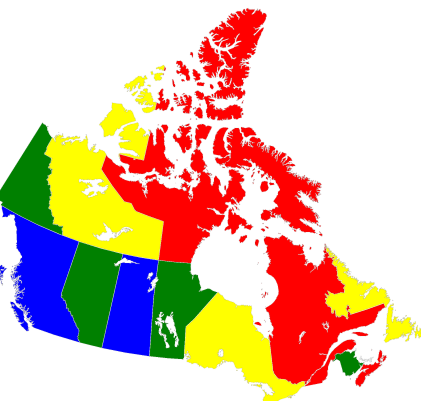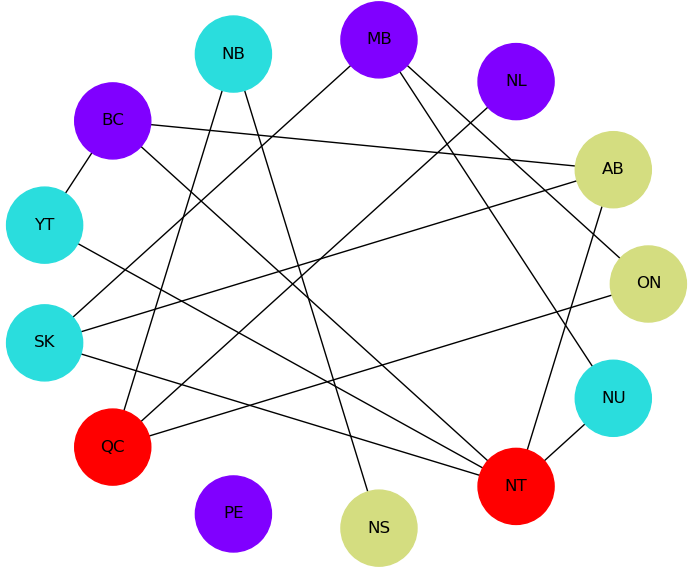Introduction#
Deprecated since version 0.3.1: dwavebinarycsp is deprecated and will be removed in Ocean 10.
For solving problems with constraints, we recommand using the hybrid
solvers in the Leap service.
You can find documentation for the hybrid solvers at Hybrid Solvers.
dwavebinarycsp is a library to construct a binary quadratic model from a constraint satisfaction problem (CSP) with small constraints over binary variables (represented as either binary values {0, 1} or spin values {-1, 1}).
For an introduction to CSPs, see Constraints.
Example: Solving a Map-Coloring CSP#
The map-coloring CSP, for example, is to assign a color to each region of a map such that any two regions sharing a border have different colors.

Coloring a map of Canada with four colors.#
The constraints for the map-coloring problem can be expressed as follows:
Each region is assigned one color only, of \(C\) possible colors.
The color assigned to one region cannot be assigned to adjacent regions.
Solving such problems as the map-coloring CSP on a sampler such as the D-Wave system necessitates that the mathematical formulation use binary variables because the solution is implemented physically with qubits, and so must translate to spins \(s_i\in\{-1,+1\}\) or equivalent binary values \(x_i\in \{0,1\}\). This means that in formulating the problem by stating it mathematically, you might use unary encoding to represent the \(C\) colors: each region is represented by \(C\) variables, one for each possible color, which is set to value \(1\) if selected, while the remaining \(C-1\) variables are \(0\).
This example finds a solution to the map-coloring problem for a map of Canada using four colors. Canada’s 13 provinces are denoted by postal codes:
Code |
Province |
Code |
Province |
|---|---|---|---|
AB |
Alberta |
BC |
British Columbia |
MB |
Manitoba |
NB |
New Brunswick |
NL |
Newfoundland and Labrador |
NS |
Nova Scotia |
NT |
Northwest Territories |
NU |
Nunavut |
ON |
Ontario |
PE |
Prince Edward Island |
QC |
Quebec |
SK |
Saskatchewan |
YT |
Yukon |
The workflow for solution is as follows:
Formulate the problem as a graph, with provinces represented as nodes and shared borders as edges, using 4 binary variables (one per color) for each province.
Create a binary constraint satisfaction problem and add all the needed constraints.
Convert to a binary quadratic model.
Sample.
Plot a valid solution, if such was found.
The following sample code creates a graph of the map with provinces as nodes and shared borders between provinces as edges (e.g., “(‘AB’, ‘BC’)” is an edge representing the shared border between British Columbia and Alberta). It creates a binary constraint satisfaction problem based on two types of constraints:
csp.add_constraint(one_color_configurations, variables)represents the constraint that each node (province) select a single color, as represented by valid configurationsone_color_configurations = {(0, 0, 0, 1), (0, 0, 1, 0), (0, 1, 0, 0), (1, 0, 0, 0)}csp.add_constraint(not_both_1, variables)represents the constraint that two nodes (provinces) with a shared edge (border) not both select the same color.
import dwavebinarycsp
from dwave.system.samplers import DWaveSampler
from dwave.system.composites import EmbeddingComposite
import networkx as nx
import matplotlib.pyplot as plt
# Represent the map as the nodes and edges of a graph
provinces = ['AB', 'BC', 'MB', 'NB', 'NL', 'NS', 'NT', 'NU', 'ON', 'PE', 'QC', 'SK', 'YT']
neighbors = [('AB', 'BC'), ('AB', 'NT'), ('AB', 'SK'), ('BC', 'NT'), ('BC', 'YT'), ('MB', 'NU'),
('MB', 'ON'), ('MB', 'SK'), ('NB', 'NS'), ('NB', 'QC'), ('NL', 'QC'), ('NT', 'NU'),
('NT', 'SK'), ('NT', 'YT'), ('ON', 'QC')]
# Function for the constraint that two nodes with a shared edge not both select one color
def not_both_1(v, u):
return not (v and u)
# Function that plots a returned sample
def plot_map(sample):
G = nx.Graph()
G.add_nodes_from(provinces)
G.add_edges_from(neighbors)
# Translate from binary to integer color representation
color_map = {}
for province in provinces:
for i in range(colors):
if sample[province+str(i)]:
color_map[province] = i
# Plot the sample with color-coded nodes
node_colors = [color_map.get(node) for node in G.nodes()]
nx.draw_circular(G, with_labels=True, node_color=node_colors, node_size=3000, cmap=plt.cm.rainbow)
plt.show()
# Valid configurations for the constraint that each node select a single color
one_color_configurations = {(0, 0, 0, 1), (0, 0, 1, 0), (0, 1, 0, 0), (1, 0, 0, 0)}
colors = len(one_color_configurations)
# Create a binary constraint satisfaction problem
csp = dwavebinarycsp.ConstraintSatisfactionProblem(dwavebinarycsp.BINARY)
# Add constraint that each node (province) select a single color
for province in provinces:
variables = [province+str(i) for i in range(colors)]
csp.add_constraint(one_color_configurations, variables)
# Add constraint that each pair of nodes with a shared edge not both select one color
for neighbor in neighbors:
v, u = neighbor
for i in range(colors):
variables = [v+str(i), u+str(i)]
csp.add_constraint(not_both_1, variables)
# Convert the binary constraint satisfaction problem to a binary quadratic model
bqm = dwavebinarycsp.stitch(csp)
# Set up a solver using the local system’s default D-Wave Cloud Client configuration file
# and sample 50 times
sampler = EmbeddingComposite(DWaveSampler()) # doctest: +SKIP
response = sampler.sample(bqm, num_reads=50) # doctest: +SKIP
# Plot the lowest-energy sample if it meets the constraints
sample = next(response.samples()) # doctest: +SKIP
if not csp.check(sample): # doctest: +SKIP
print("Failed to color map")
else:
plot_map(sample)
The plot shows a solution returned by the D-Wave solver. No provinces sharing a border have the same color.

Solution for a map of Canada with four colors. The graph comprises 13 nodes representing provinces connected by edges representing shared borders. No two nodes connected by an edge share a color.#